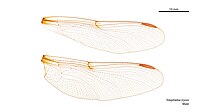Telephlebia tryoni
| Coastal evening darner | |
|---|---|

| |
| Female | |
| Scientific classification | |
| Kingdom: | Animalia |
| Phylum: | Arthropoda |
| Class: | Insecta |
| Order: | Odonata |
| Infraorder: | Anisoptera |
| Family: | Telephlebiidae |
| Genus: | Telephlebia |
| Species: | T. tryoni
|
| Binomial name | |
| Telephlebia tryoni | |

| |
Telephlebia tryoni is a species of dragonfly in the family Telephlebiidae,[3] known as the coastal evening darner.[4] It is a medium to large, dark chestnut brown dragonfly with dark markings on the leading edge and base of its wings.[5] It is endemic to eastern Australia,[4] where it has been found along streams in rainforests and open areas,[6] and flies at dusk.[5]
Gallery[]

Female wings

Male wings
See also[]
References[]
| Wikimedia Commons has media related to Telephlebia tryoni. |
- ^ Dow, R.A. (2017). "Telephlebia tryoni". IUCN Red List of Threatened Species. 2017: e.T14260009A59256463. doi:10.2305/IUCN.UK.2017-1.RLTS.T14260009A59256463.en. Retrieved 20 November 2021.
- ^ Tillyard, R.J. (1917). "On some new dragonflies from Australia and Tasmania (Order Odonata)". Proceedings of the Linnean Society of New South Wales. 42: 450–479 [459]. doi:10.5962/bhl.part.4860 – via Biodiversity Heritage Library.
- ^ "Species Telephlebia tryoni Tillyard, 1917". Australian Faunal Directory. Australian Biological Resources Study. 2012. Retrieved 20 March 2017.
- ^ a b Theischinger, Günther; Hawking, John (2006). The Complete Field Guide to Dragonflies of Australia. Collingwood, Victoria, Australia: CSIRO Publishing. p. 144. ISBN 978-0-64309-073-6.
- ^ a b Watson, J.A.L.; Theischinger, G.; Abbey, H.M. (1991). The Australian Dragonflies: A Guide to the Identification, Distributions and Habitats of Australian Odonata. Melbourne: CSIRO. ISBN 0643051368.
- ^ Theischinger, Gunther; Endersby, Ian (2009). Identification Guide to the Australian Odonata (PDF). Department of Environment, Climate Change and Water NSW. p. 239. ISBN 978-1-74232-475-3.
Categories:
- IUCN Red List near threatened species
- Telephlebiidae
- Odonata of Australia
- Endemic fauna of Australia
- Taxa named by Robert John Tillyard
- Insects described in 1917


